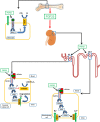Physiological Actions of Fibroblast Growth Factor-23
- PMID: 29892265
- PMCID: PMC5985418
- DOI: 10.3389/fendo.2018.00267
Physiological Actions of Fibroblast Growth Factor-23
Abstract
Fibroblast growth factor-23 (FGF23) is a bone-derived hormone suppressing phosphate reabsorption and vitamin D hormone synthesis in the kidney. At physiological concentrations of the hormone, the endocrine actions of FGF23 in the kidney are αKlotho-dependent, because high-affinity binding of FGF23 to FGF receptors requires the presence of the co-receptor αKlotho on target cells. It is well established that excessive concentrations of intact FGF23 in the blood lead to phosphate wasting in patients with normal kidney function. Based on the importance of diseases associated with gain of FGF23 function such as phosphate-wasting diseases and chronic kidney disease, a large body of literature has focused on the pathophysiological consequences of FGF23 excess. Less emphasis has been put on the role of FGF23 in normal physiology. Nevertheless, during recent years, lessons we have learned from loss-of-function models have shown that besides the paramount physiological roles of FGF23 in the control of 1α-hydroxylase expression and of apical membrane expression of sodium-phosphate co-transporters in proximal renal tubules, FGF23 also is an important stimulator of calcium and sodium reabsorption in distal renal tubules. In addition, there is an emerging role of FGF23 as an auto-/paracrine regulator of alkaline phosphatase expression and mineralization in bone. In contrast to the renal actions of FGF23, the FGF23-mediated suppression of alkaline phosphatase in bone is αKlotho-independent. Moreover, FGF23 may be a physiological suppressor of differentiation of hematopoietic stem cells into the erythroid lineage in the bone microenvironment. At present, there is little evidence for a physiological role of FGF23 in organs other than kidney and bone. The purpose of this mini-review is to highlight the current knowledge about the complex physiological functions of FGF23.
Keywords: 1α-hydroxylase; Klotho; alkaline phosphatase; bone mineralization; fibroblast growth factor-23; phosphate metabolism; vitamin D.
Figures

References
Publication types
Grants and funding
LinkOut - more resources
Full Text Sources
Other Literature Sources

